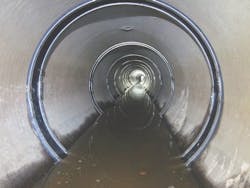Internal Joint Sealing System Prevents Further Pavement Settlement
About the author:
Cretex
www.cretexseals.com | 800.345.3764
In May 2017, the Michigan Department of Transportation (MDOT) discovered pavement failures in the westbound lane of I-94 in New Buffalo, Mich., near the weigh station close to the Michigan border. Further inspection revealed that a 1,000-ft-long, 72-ft-diameter, reinforced concrete pipe conduit running under the interstate highway had joint separation and deflection issues. The joint issues were allowing the sandy native soil to migrate into the pipe, undermining the roadway bedding above it and causing the pavement to settle.
MDOT engineers consulted with the central region engineer at the American Concrete Pipe Assn. (ACPA) to brainstorm options for repairing the joint issues. The ACPA referred MDOT engineers to a manufacturer's representative for Cretex Specialty Products, who assisted in the recommendation of the Cretex HydraTite internal pipe joint seals system for the repairs. The system is a mechanical, trenchless remediation technology for leaking pipe joints consisting of a proprietary rubber seal that spans the joint and is held in place by stain- less steel retaining bands on either side of the joint. The retaining bands are hydraulically expanded and permanently locked in place.
After a site visit by Cretex, the local representative and MDOT engineers, the proper number of seals and appropriate seal widths were determined by walking the pipeline and inspecting it in early June 2017. MDOT was in a hurry to finish the repairs, which consisted of pipe-joint seal installation and grout injection from the surface to stabilize the soils around the pipe. The job was bid July 7, 2017. Kamminga & Roodvoets Inc. of Grand Rapids, Mich., was awarded the job, and construction began Aug. 21, 2017. It took only one week to install all 115 seals.


